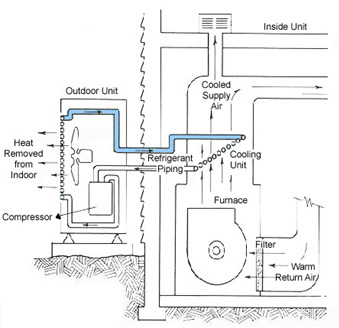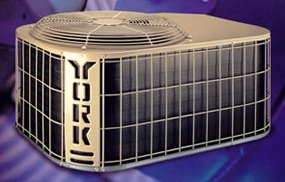central air conditioner

A central air conditioner is an air conditioner that circulates cool air through a system of supply and return ducts. Supply ducts and registers (i.e., openings in the walls, floors, or ceilings covered by grills) carry cooled air from the air conditioner to the home. This cooled air becomes warmer as it circulates through the home; then it flows back to the central air conditioner through return ducts and registers.
Air conditioners help to dehumidify the incoming air, but in extremely humid climates or in cases where the air conditioner is oversized, it may not achieve a low humidity. Running a dehumidifier in your air conditioned home will increase your energy use, both for the dehumidifier itself and because the air conditioner will require more energy to cool your house. A preferable alternative is a dehumidifying heat pipe, which can be added as a retrofit to most existing systems.
Types of central air conditioners
A central air conditioner is either a split-system unit or a packaged unit.
In a split-system central air conditioner, an outdoor metal cabinet contains the condenser and compressor, and an indoor cabinet contains the evaporator. In many split-system air conditioners, this indoor cabinet also contains a furnace or the indoor part of a heat pump. The air conditioner's evaporator coil is installed in the cabinet or main supply duct of this furnace or heat pump. If your home already has a furnace but no air conditioner, a split-system is the most economical central air conditioner to install.
In a packaged central air conditioner, the evaporator, condenser, and compressor are all located in one cabinet, which usually is placed on a roof or on a concrete slab next to the house's foundation. This type of air conditioner also is used in small commercial buildings. Air supply and return ducts come from indoors through the home's exterior wall or roof to connect with the packaged air conditioner, which is usually located outdoors. Packaged air conditioners often include electric heating coils or a natural gas furnace. This combination of air conditioner and central heater eliminates the need for a separate furnace indoors.
Choosing or upgrading your central air conditioner
 |
| York Olympian TS series high-efficiency
central air conditioner
|
Central air conditioners are more efficient than room (window) air conditioners. In addition, they are out of the way, quiet, and convenient to operate. To save energy and money, you should try to buy an energy-efficient air conditioner and reduce your central air conditioner's energy use. In an average air-conditioned home, air conditioning consumes more than 2000 kilowatt-hours of electricity per year, causing power plants to emit about 3500 pounds of carbon dioxide and 31 pounds of sulfur dioxide.
If you are considering adding central air conditioning to your home, the deciding factor may be the need for ductwork. See the section on limitations when replacing existing systems for more information.
If you have an older central air conditioner, you might choose to replace the outdoor compressor with a modern, high-efficiency unit. If you do so, consult a local heating and cooling contractor to assure that the new compressor is properly matched to the indoor unit. However, considering recent changes in refrigerants and air conditioning designs, it might be wiser to replace the entire system.
Today's best air conditioners use 30–50% less energy to produce the same amount of cooling as air conditioners made in the mid 1970s. Even if your air conditioner is only 10 years old, you may save 20–40% of your cooling energy costs by replacing it with a newer, more efficient model.
Proper sizing and installation are key elements in determining air conditioner efficiency. Too large a unit will not adequately remove humidity. Too small a unit will not be able to attain a comfortable temperature on the hottest days. Improper unit location, lack of insulation, and improper duct installation can greatly diminish efficiency.
When buying an air conditioner, look for a model with a high efficiency. Central air conditioners are rated according to their seasonal energy efficiency ratio (SEER). SEER indicates the relative amount of energy needed to provide a specific cooling output. Many older systems have SEER ratings of 6 or less. The minimum SEER allowed today is 10 for a split system and 9.7 for a single-package system. Look for the ENERGY STAR label for central air conditioners with SEER ratings or 12 or greater, but consider using air conditioning equipment with SEER ratings of 14 or greater to achieve performance levels greater than 30% savings.
New residential central air conditioner standards are scheduled to go into effect on January 26, 2006. Air conditioners manufactured after January 26, 2006 must achieve a Seasonal Energy Efficiency Ratio (SEER) of 13 or higher. SEER 13 is 30% more efficient than the current minimum SEER of 10. The standard applies only to appliances manufactured after January 26, 2006. Equipment with a rating less than SEER 13 manufactured before this date may still be sold and installed.
The average homeowner will remain unaffected by this standard change for some time to come. The standards will not require you to change your existing central air conditioning units, and replacement parts and services should still be available for your home's systems. The "lifespan" of a central air conditioner is about 15 to 20 years. Manufacturers typically continue to support existing equipment by making replacement parts available and honoring maintenance contracts after the new standard goes into effect.
Other features to look for when buying an air conditioner:
Installation and location of air conditioners
If your air conditioner is installed correctly, or if major installation problems are found and fixed, it will perform efficiently for years with only minor routine maintenance. However, many air conditioners are not installed correctly. As an unfortunate result, modern energy-efficient air conditioners can perform almost as poorly as older inefficient models.
Be sure that your contractor performs the following procedures when installing a new central air conditioning system:
If you are replacing an older or failed split system, be sure that the evaporator coil is replaced with a new one that exactly matches the condenser coil in the new condensing unit. (The air conditioner's efficiency will likely not improve if the existing evaporator coil is left in place; in fact, the old coil could cause the new compressor to fail prematurely.)
